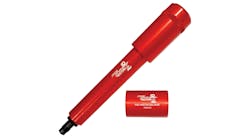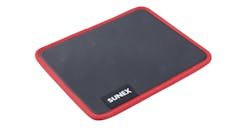While cordless power tools have certainly made strides in the technician’s tool arsenal, many shops still rely heavily, if not solely, on the use of pneumatic air tools.
While pneumatic tools require compressed air in order to operate, the tool weight and product longevity provide techs with a viable option for everyday shop use.
Air tools are constructed out of different material than power tools, and have fewer moving parts.
“The big differences now ultimately come down to weight. Air tools are much lighter than cordless tools, for the same comparable power,” says Eric Suros, director of product management for vehicle services and industrial products, Ingersoll Rand.
“The most obvious advantage with air tools is that you never need to charge them, they usually cost less, and you have access to endless and constant power,” adds Chris Simpson, product manager, King Tony America.
Because pneumatic tools run on shop air, Simpson explains that it’s important for a shop to be prepared for the amount of air needed to operate all of the tools in the shop. (For an overview of compressed air systems, visit VehicleServicePros.com/12075361)
Tool categories and sizes
Impact wrenches and ratchets
Technicians use impact wrenches daily in the shop. Impact wrenches and impact ratchets have similar applications, in terms of fastener installation and removal. The application depends on where on the vehicle the technician is working.
“Most impact wrenches are manufactured with a built-in air regulator, allowing the adjustment of the torque output of the tool,” explains Ben Echtenkamp, commercial product development manager, Campbell Hausfeld.
Drive sizes available for impact wrenches include: 1/4”, 3/8”, ½”, ¾”, 1” and 1-1/2”. The smaller the drive size, the less torque the tool provides. This can be beneficial for getting into tight areas, where more finesse is needed, versus power.
Larger drive impacts (3/4” and larger) are used for lug nuts and larger equipment applications.
Suros explains that impact wrenches are often used to remove stubborn lug nuts and stuck bolts, while ratchets assist techs with accessing tight spaces where an impact wrench may not fit, including underdash and under hood applications such as the engine compartment.
Impact ratchets are available in smaller drive sizes, including: 1/4", 3/8” and 1/2".
Grinders, sanders/polishers
Oftentimes grinders and sander/polishers can be found primarily in body shops, but this tool category also has a place in the general automotive repair shop as well, including grinding, deburring, cutting metals and surface prep.
Impact grinders and die grinders are used in general auto shop applications to remove rust and corrosion from areas of the vehicle, including rotors, according to Suros. “Bigger grinders are used for a bigger surface area, to remove more corrosion and debris.”
Die grinders are smaller and used to access hard-to-reach areas of a vehicle. “(A die grinder) uses a collet instead of a thread. On a regular grinder you use a grinding disc,” Suros explains. “The collet is used to put on stones, zip wheels or other tiny abrasives to get into tighter spaces.”
Die grinders come in a number of collet sizes, including: 6mm, 1/8”, 1/4” or 3/8”, with 1/8” and 1/4” collet sizes being most popular.
“Depending on your needs the grinder can be mini in size, full size or come with extended body to have a longer reach. Most tools have composite body so the exhaust air does not freeze your hands. The air exhaust can be front exhaust or rear exhaust,” says Echtenkamp.
Regarding orbital sanders, Echtencamp explains: “All have a variable-speed regulator, exhaust port with a muffler system and some come with extend handle to rest your wrist. Most advertise low vibration and lightweight.”
Radius sizes for orbital sanders include: 3/32”, 3/16” and 3/8”.
“Orbit radius 3/32” removes material at a slow pace for ultra-fine sanding, 3/8” is for aggressive sanding and 3/16” is the size most popular,” says Echtenkamp.
Features techs want
There are a number of features that technicians look at when purchasing a new air tool, such as tool durability, reliability, weight, design, operator comfort, full torque range including maximum torque output and the location of controls.
“Composite housings with twin hammer mechanisms are the most popular design on the market,” says Echtenkamp. “Other features an impact may have are bottom-of-handle air exhaust, an air regulator for adjusting the torque, extended anvil and full-stroke tease trigger.”
He also explains that when impacts are used daily in the shop, tool weight and durability become much more important to techs.
Because power is important for fastener removal, many techs include maximum torque and tool weight at the top of their list for impact wrenches.
Le Neveu says that techs have preferences for different design features for impact ratchets, that include “reaction-less” “flat head” and “conventional” mechanisms.
For sanders and grinders, users consider free speed, tool weight, vibration levels, wheel, pad and collet sizes and overall operating comfort, says Tony Le Neveu, VP of sales and engineering, Florida Pneumatic.
“For orbital sanders the trend is heavily towards palm grip styles that provide one-hand operation,” he continues. “Most manufacturers also offer options of the orbit size for palm sanders that provide varying levels of surface finish and material removal speed.”
With these features, pneumatic tools continue to evolve.
“With innovation comes qualities such as smaller, lighter, more torque, quieter, and more reliable. A good warranty always is a plus to cover any defects that may be found,” says Simpson.
If your customer already has the proper air tools for the job, or you would like to package additional items with a purchase, consider selling accessories for pneumatics. Accessory options include, but are not limited to:
- Impact sockets (wrenches and ratchets)
- Extension bars (wrenches and ratchets)
- Tool boots (protective coverings that go over the body of the tool)
- Sanding and polishing discs and pads (sanders)
- Grinding wheels and stones (grinders)
- Drill bits (drills)
- Gloves
- Air hoses and couplers
Many techs may already prefer one brand based on previous experience. When selling air tools on the truck, it’s important to let the customer handle and use the product. Lend the tool to your customer for a week so he can test it out during on-the-job repairs.
“As far as showcasing a tool it is always better to see it live outside the box, it lets a customer pick up the tool, feel the ergonomics, and begin to form an attachment to that tool,” says Echtenkamp.


